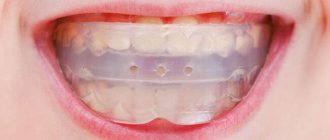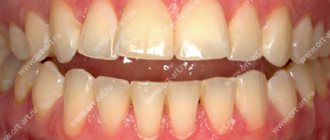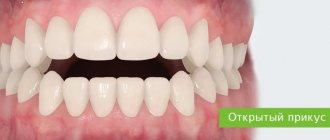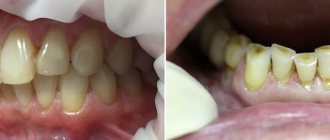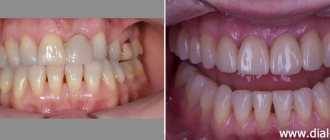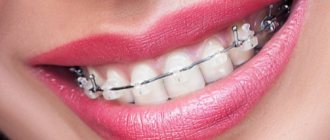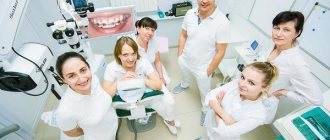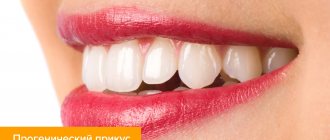Orthodontic treatment
is the process of correcting malocclusion. Experts say that about 90% of the world's population has some kind of defect in the arrangement of teeth. It’s just that for some it is clearly expressed, while for others it is quite well hidden and unnoticeable to others.
Orthodontic treatment with aligners is the most comfortable, fastest and most invisible to others!
I would like a consultation on orthodontic treatment with aligners!
However, there are also cases when the patient is satisfied with everything in his smile, but orthodontists strongly recommend that he correct his bite. This is due to the fact that incorrect positioning of teeth can cause serious problems not only with the patient’s teeth themselves, but also with health:
- Poor chewing of food due to loose teeth contacts is often the cause of stomach ulcers and diseases of the gastrointestinal tract.
- Malocclusion is an ideal environment for the development of periodontitis. With this disease, infections dominate the human oral cavity, often spreading to internal organs.
- In addition, there is a constant unpleasant odor in the mouth. Even if you brush your teeth often and use mouth fresheners.
- Malocclusion always affects the temporomandibular joints (TMJ). As an adult, a TMJ problem will cause many negative symptoms, such as severe headaches.
This is why orthodontists sometimes prescribe orthodontic treatment for malocclusion, even if the smile visually looks perfect.
Let's start with pediatric orthodontics. Many problems with a child’s teeth begin in early childhood and develop in kindergarten and early school age, but parents are in no hurry to take their child to a pediatric orthodontist. Why? Because many parents have this opinion:
Types of orthodontic structures
A lot of orthodontic devices have been developed, but they all belong to one of two large groups:
- removable;
- non-removable.
Removable structures
This group includes:
- mouth guards;
- vestibular plates;
- trainers.
Such structures are most often used in pediatric orthodontics to correct the bite of baby teeth.
Among adult patients, special mouthguards for correcting bites are very popular. But these designs are effective only for minor bite defects. Treatment with their help is expensive, time-consuming and useless for serious malocclusions. The choice of teeth straightening technology should be entrusted to a specialist. To do this, you need to sign up for a consultation at a serious dental clinic and certainly not engage in self-diagnosis and self-medication.
Fixed structures
They are mainly represented by fairly well-known bracket systems, of which there are several types, differing in materials and design. Materials used for the production of braces:
- metal;
- ceramics;
- plastic;
- sapphires;
- gold.
Some models of braces are located on the outer side of the dentition, they are called vestibular, others on the inner side, on the side of the tongue, lingual.
You should take your child to a pediatric orthodontist only when he has all his permanent teeth.
Orthodontist, candidate of medical sciences Tatyana Gevorkyan comments:
Unfortunately, this attitude towards orthodontic treatment among parents in childhood is a myth, very widespread and, alas, harmful. Very often, dentists themselves contribute to this myth about pediatric orthodontists. I don’t really want to comment on the degree of immersion in the issues of pediatric orthodontics of these specialists and their competence, but discussions about the advisability and necessity of the so-called early orthodontic treatment (that is, in childhood) do not subside to this day. And again, sometimes this situation actually happens: a child began undergoing orthodontic treatment in preschool or early school age, both the child and the parents tried, wore, and monitored the wearing of the orthodontic apparatus, and when the bite changed, the children’s orthodontist still installed braces. system...
A question immediately arises, mixed with parental indignation: why did the pediatric orthodontist have to “torment” the child for so long when he was given braces anyway?!! This is where this myth comes from: whatever one may say, braces are, like, the coolest thing for children’s and adult orthodontists, which solves all problems “at once.” But no! The braces system does not solve all the problems of orthodontic treatment in a child.
Orthodontic treatment in childhood is the fastest and most effective!
Growing patients—children and adolescents—are the most rewarding environment for a pediatric orthodontist to work in. Why? Everything is very simple and lies on the surface: in children and adolescents, the processes of growth, renewal, and metabolic processes are most active. Therefore, the same orthodontic force applied to a growing and non-growing patient can produce completely different results, with an advantage, of course, in growing patients.
In a very large percentage of cases, with timely initiation of orthodontic treatment in children, the need to install braces can be avoided. Here, of course, good, if not excellent, cooperation (that is, help from the pediatric orthodontist) on the part of the patient himself and, of course, the patient’s parents is extremely important, because children and adolescents very often still lack the motivation to follow the orthodontist’s recommendations. However, orthodontics is not magic... It also happens that the anomaly is so serious that the potential of simpler devices is not enough. In such cases, we, orthodontists, are forced to fix the braces in order to complete the treatment. But! A pediatric orthodontist should always warn parents that with conscientious early orthodontic treatment, we will in any case avoid more complex and severe pathology, thereby reducing the time of wearing braces in the future (or aligners in adolescence). This is also extremely important.
In this video, famous orthodontist Alexey Trezubov recommends young boys and girls to correct their teeth using aligners. They are invisible, light and comfortable to wear. Much better than braces, which are visible on the teeth, which you are tortured to brush constantly, since everything gets stuck in them and it is impossible to eat normally! In general, aligners are already a stable youth trend:
Thus, let’s sum up an intermediate result on orthodontic treatment in childhood: indeed, braces can correct a lot during orthodontic treatment, but wearing braces is a rather serious test for the body, and if there are options to avoid wearing braces or shorten the period of their use, then it is better do it. And early orthodontic treatment in children is the very option when it is possible to prevent a more serious anomaly, and therefore reduce the likelihood of the need for a pediatric orthodontist to install braces or reduce the likelihood of wearing them. Therefore, do not delay: it is better to go with your child, starting from the age of 3-4 years, for a consultation with a pediatric orthodontist and get all the information, than then frantically look for the most “light”, that is, easy options for solving problems where more serious orthodontic treatment is already required treatment with mouth guards.
Where else are 3D technologies used?
3D technologies, among other things, make it possible to provide services for the production of orthodontic systems: you can create a crown or prosthesis using a digital model, or scan a dental impression provided by the client, load it into a modeling program and create any necessary products from it: crowns, bridges, etc.
Thus, during implantation, 3D scanning data is especially important. They allow you to plan treatment as accurately as possible: determine the quality and structure of the bone, the location of nerves and blood vessels, choose the correct location for the implant and create a special template for the surgeon. No other diagnostic method provides such accurate data. The most modern ones - orthopantomogram and teleradiography - are inferior to 3D technology. The first creates only a two-dimensional model, the second can distort the image if the client’s head is in the wrong position.
Using 3D technology, any orthodontic structures are manufactured with high precision and in a short time
How is malocclusion treated during orthodontic treatment?
Today, orthodontists use several technologies that can correct misaligned teeth. There are many of them: plates, braces, aligners, twin blocks, etc. We'll show you the three most popular ones.
First technology - orthodontic plates
The main advantage of such plates is that they are removable. Depending on the condition of the bite, they can be worn around the clock or put on only at night. Due to the questionable effectiveness of treatments, they are practically not used, or are used only in the simplest cases.
The second technology of orthodontic treatment is braces.
Absolutely everyone knows about braces. Previously, these were ugly metal staples that turned the smile of the Jaws character from the James Bond film into a grin,
Today, braces are quite aesthetic and easy to use. According to the design on the teeth, braces are a permanent structure, that is, they are worn for a certain time (1-3 years), without ever being removed. Braces come in many types, such as self-ligating, ceramic, sapphire and lingual. Only the last of these, lingual braces, are invisible during orthodontic treatment.
The third technology of orthodontic treatment is aligners.
This technology, which appeared about 30 years ago, has reached us in a much improved form. The obvious advantage of aligners is that they are removable and invisible when worn. That is, the patient’s orthodontic treatment goes unnoticed by others. Even if a person corrects his teeth using this technology, no one will guess that he is wearing clear aligners. The disadvantage is that it does not correct all types of bites, although the most basic pathologies are easily treated with aligners.
The advantage of orthodontic treatment with aligners is the opportunity to see the results of your treatment BEFORE it begins. This opportunity is provided to the patient thanks to a special computer program - a virtual 3D setup. See for yourself how a bite is corrected using aligners, it’s a very exciting process:
Orthodontic treatment for straightening central upper teeth
This video discusses a case of orthodontic treatment, when a patient consults an orthodontist in order to correct the position of the two central incisors on the upper jaw: he has a changed position of one upper incisor (quite strong) - the incisor is rotated along the axis, and, let’s say, deviated with the edge forward.
That is, from a cosmetic point of view, we understand perfectly well that this is not a very beautiful position of the central teeth and, naturally, we want to correct it. The aligners dealt with this problem perfectly.
Orthodontic treatment of crossbite
The very name of crossbite already contains a small meaning of such a pathology, which is not always easy for orthodontic treatment. And the presented clinical case is no exception. In this case, the patient had a situation where the upper teeth, the upper dentition, are quite narrow. It turns out that the lower teeth OVERLOAD the outer surface of the upper teeth. Everything should be the other way around: our upper jaw should be wider and larger than our lower jaw. In addition, in the video we will see the deformation and incorrect position of the front teeth in the upper jaw, in particular, the so-called “lateral incisors”: they are in the posterior, palatal position. And again, as in the previous case, the aligners did an excellent job of solving the problem during the patient’s orthodontic treatment.
Orthodontic treatment when the fangs are crooked and need to be corrected
This video examines a rather interesting case. We will see with you not just the alignment of individual teeth and the magic of how aligners work, but we will also see HOW, with the help of aligners, we can correct the bite during orthodontic treatment.
Pay attention to the position of the lower canines. They are very much rotated along the axis. Orthodontists call this “rotation.” Therefore, here we present a rather complex movement during orthodontic treatment with aligners, a complex correction, since a canine is a fairly powerful tooth and we do not always easily cope with such problems even with braces. But again, the aligners did a great job!
Orthodontic treatment of crowded teeth using aligners
This video shows an example of a clinical case of crowded teeth, where not very straight front teeth become a beautiful, even, wide smile during orthodontic treatment with aligners.
Pay special attention to the upper jaw, where you can see excessive inclination of the front teeth, that is, when the teeth tilt very much back. In response to this, other teeth - the lateral incisors - visually seem to be tilted forward. From the inside we will see a not very even upper dentition, that is, the upper jaw has the shape of a trapezoid, the teeth are crowded, which is not the norm - after all, our jaw should be semicircular, semi-ellipsoidal, wide, bright.
And if you look at the lower jaw, you can also see a fairly high crowding of the teeth, a high, close position of the lower incisors. This is very common in almost all of us.
. And doctors very often hear from patients that it is very difficult to brush such teeth, and therefore there is a lot of dental plaque. With such crowded teeth, a person will always experience discomfort and seek professional hygiene.
As a result of orthodontic treatment with aligners, crowded teeth were completely eliminated and all the patient’s problems were a thing of the past!
Cost of orthodontic treatment with Star Smile aligners
The Star Smile company is a leading Russian manufacturer of aligners and therefore offers you the most comfortable and reasonable prices for orthodontic treatment. Star Smile is represented by certified specialists in more than 70 cities of Russia and neighboring countries.
Installment plans will also help you effectively begin orthodontic treatment: patients have the opportunity to undergo orthodontic treatment at a cost of:
- for the simplest case of correction from 6,000 rubles
per month - in the most difficult case of teeth straightening - less than 10,000 rubles
per month
Realistically, today these are the lowest possible prices for aligners in Russia!
Find out the prices for orthodontic treatment with aligners for your pathology
Teeth color correction
When creating the perfect smile, you often have to adjust the color of your teeth. You can use enamel whitening, install veneers or perform professional hygiene.
When are veneers used:
- When the crown darkens;
- When chipped;
- For yellowed teeth (tetracycline);
- If bleaching is ineffective;
- With high sensitivity of teeth;
- If, in addition to the previous problems, the teeth are crooked, since veneers and lumineers also change their shape.
What else is important to know about orthodontic treatment?
- Sometimes, to successfully correct a malocclusion during orthodontic treatment, it is necessary to remove individual teeth. Often they are the ones that displace the remaining teeth and prevent the formation of a healthy bite. This operation may frighten you, but orthodontists do not offer unnecessary services if they really can be avoided.
- Before agreeing to treatment, make sure that the orthodontist you choose is qualified. Try to read reviews about this clinic on the Internet, ask around on the forums. The high cost of orthodontic treatment does not always indicate the professionalism of the orthodontist. There is no point in focusing on prices in this matter. Correcting a bite takes several years - and this is a considerable waste of time if the doctor suddenly turns out to be an inexperienced specialist.
- Many orthodontists prescribe treatment with braces, even if the patient chooses aligners. The reason is simple - braces must be constantly adjusted during treatment, which invariably leads to additional payments for the doctor’s work. With aligners, the orthodontist’s work is reduced to almost nothing, so the orthodontist will not be able to make money on you from monthly procedures either.
- Although you can undergo orthodontic treatment with aligners in more than 70 cities in Russia, naturally, treatment with aligners is not practiced in all clinics. This is also one of the reasons why orthodontists impose braces. You can view the list of clinics that work with aligners and make an appointment in your city on the Where to get treatment page.
- Finally, you must understand how much orthodontic treatment you need and what it involves.
Diagnostics
In order to correctly select a treatment plan and means for its implementation, it is necessary to conduct diagnostic studies and calculations, or, more simply, “diagnosis”.
It includes the calculation of x-rays - an orthopantomogram (a panoramic photograph of both jaws and a teleroentgenogram (a photograph of the skull bones in a lateral projection), diagnostic models of the jaws (we obtain models from impressions of your teeth) and photographs of the face and teeth. Based on the data obtained, the orthodontist draws up a treatment plan and selects the necessary equipment.In some cases, additional examinations may be required, such as: targeted x-ray (specifying, in the area of one tooth), computed tomography of a certain area, magnetic resonance imaging, allergy tests for orthodontic elements used at the appointment.
The following issues are resolved during diagnostics:
- What is the expected duration of treatment, what stages it will consist of;
- Treatment will take place with or without tooth extraction. If teeth are removed, which ones and when?
- Choosing an orthodontic appliance.
The duration of orthodontic treatment depends on the type of pathology, the condition of the bone tissue, and the age of the patient. Treatment consists of two stages: “active” and “passive”.
Orthodontic treatment with aligners is the most comfortable, fastest and most invisible to others!
Orthodontic treatment with Star Smile aligners is truly the most comfortable for you today and invisible to others.
The result of orthodontic treatment is always 100%. And - we predict! Star Smile orthodontists work in more than 70 cities of Russia, and we can offer you competent, detailed consultation in your city!
Do you want to consult on the problem of orthodontic treatment? We promise that after treatment with aligners you will forever forget about the malocclusion, which now causes you discomfort and, possibly, overloads the temporomandibular joint.
Types of orthodontic equipment
Orthodontic equipment today is very diverse.
To treat children with primary and mixed dentition, removable devices are used: single- and double-jaw plates, trainers, LM-activators. These devices are needed to correct the position and size of the jaws. They practically do not eliminate the position and rotation of individual teeth. This can only be corrected with the help of non-removable equipment (brackets).
For the treatment of adult patients with mixed and permanent dentition, a brace system is used. It is a set of clasps for each tooth, a set of arches that differ in size, chemical composition and function, as well as metal and elastic elements to hold the arch in the bracket groove. Using a specific sequence of arch replacement, the shape of the dental arch and the position of individual teeth are corrected.
Currently, microimplants are beginning to be widely used in orthodontic practice. These are additional devices for treatment using fixed equipment. They are mini-screws that are screwed into the gum under local anesthesia in the desired area. Microimplants are used to close spaces after tooth extraction, to close the gap between the upper and lower teeth (correction of an open bite), for tooth retention (when normal eruption did not take place for one reason or another), and to straighten the inclination of chewing teeth.
What is orthodontics?
Orthodontics is one of the areas in dentistry. Doctors who work in this direction are called orthodontists.
Orthodontic treatment is aimed at diagnosing, preventing and treating dental anomalies. After completing a full course of treatment from a specialist, a person will be able to get rid of developmental defects of dental anomalies and get a perfect smile. After treatment, a person will no longer feel headaches after eating, and pain in the neck and back will go away. Thus, the treatment will affect not only the dentition, but also the entire body.
Central ratio
Today there is insufficient scientific data to formulate the optimal parameters of harmonious functional occlusion. The issue of determining optimal functional occlusion has been discussed for more than 100 years. The very definition of the term “central ratio” (CR) has changed repeatedly over the course of 50 years.
According to numerous studies, there are many acceptable positions of the head of the mandible in the glenoid fossa, but there is no one, universal CS that would be optimal for everyone. In addition, the specific position of the mandibular heads associated with TMD is unknown. Logically, a relatively anterior position of the head of the mandible is preferable to a posterior abducted position. But, being healthy, the TMJ can adapt to the posterior position of the head of the lower jaw. Despite the wide range of acceptable positions of the head of the mandible, not everyone can adapt to any specific position of the TMJ, and the ability to adapt varies greatly among different people. For some, the optimal position is relatively average; for others, a higher and anterior position of the heads of the lower jaw is optimal. It is worth noting that the exact localization of the central nervous system may vary to some extent in the same person during the day. This feature depends on many factors, including fatigue of the masticatory muscles, posture and tongue position.
